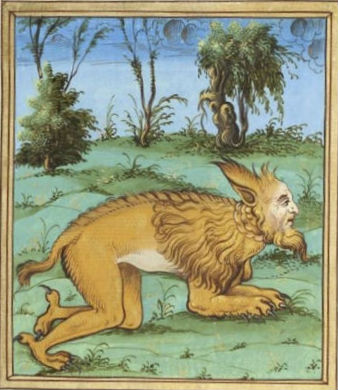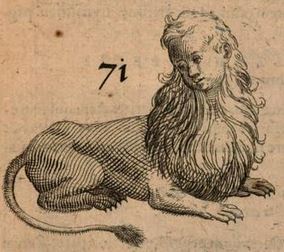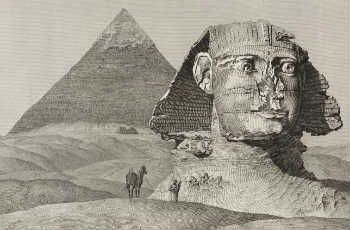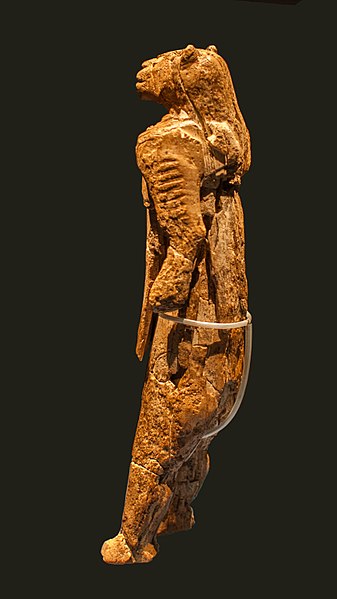Lion-human hybrids
Mammalian Hybrids
|
Again, Egyptian artificers in their sculpture, and the vainglorious legends of Thebes attempt to represent the Sphinx, with her two-fold nature, as of two-fold shape, making her awe-inspiring by fusing the body of a maiden with that of a lion.
—Aelian, On Animals 12:7
|
 Lion-human hybrid from a medieval manuscript.
Lion-human hybrid from a medieval manuscript.
in this context it is also perhaps worth mentioning that in his Topographia hibernica (Ch. XXIV) the Welsh-Norman historian Gerald of Wales (c. 1147 – c. 1223) bemoans his encounter in Paris with a certain woman Johanna who regularly slept with a lion.
A few very early and sketchy reports refer to lion-human hybrids. Thus, the German physician Johann Ludwig Hannemann (in Bartholin, Acta Medica et Philosophica Hafniensia, 1676, vol. 4, part 1, observation xi), a professor of medicine at the University of Kiel, reported that a young woman at Buxtehude had given birth, from the same pregnancy, to a normal child and to a stillborn fetus with the head of a lion.§
According to the early Swiss historian Johann Stumpf (1500 – c. 1578), a noblewoman at Sempach in the year 1278 gave birth to a lion (Gemeiner loblicher Eydgnoschafft Stetten, Landen und Voelckeren Chronick wirdiger thaaten Beschreybung, pp. 240-241). The same claim appears in the Nuremberg Chronicle (ccxvii), an incunable first printed in 1493. This allegation was included in various subsequent lists of abnormal births as if it were a fact (e.g., Schenck 1596, p. 604, Delrio 1755, p. 148b). Sempach is a municipality in Switzerland.
 A supposed lion-human hybrid born at Konstanz, as pictured in Schenk (1609, p. 99, fig. 71)
A supposed lion-human hybrid born at Konstanz, as pictured in Schenk (1609, p. 99, fig. 71)
In a similar account, Conrad Lycosthenes says that a woman gave birth to a lion with a human head in the year 1290 at Konstanz, a city in southern Germany (Prodigiorum ac ostentorum chronicon, p. 447). Given the similar date of Lycosthenes’ account, it may be simply a garbled version of the lion-baby stories just cited. Sebastian Franck (Chronica, 1543, p. 228) also mentions such a hybrid as being born at Konstanz, but dates it to the year 1274. This bodily configuration, obviously, would be like that of the Great Sphinx at Giza.

In The Gods of the Egyptians (vol. I, p. 446), Sir Wallace Budge says that one of the primary goddesses of ancient Egypt, Bast, was originally represented with a cat’s head and that the use of a lion head in her representations came much later: “The form in which the goddess was worshiped in the earliest times was that of a cat, and her identification with a lioness probably belongs to a comparatively late period.” So it seems that the cat was worshiped both far earlier and more frequently in Egypt than the lion. Therefore the Great Sphinx of Giza, which is one of the oldest Egyptian monuments, dating to the early part of the third millennium BCE, may have been meant to represent a human-cat hybrid, and not a human-lion, as is often supposed.
By the same author: Handbook of Avian Hybrids of the World, Oxford University Press (2006).
 The Löwenmensch (“lion-man”), a lion-headed figurine with a human-like body found at Stadel Cave, Baden-Württemberg, Germany, in 1939. Carved out of mammoth ivory, it is the oldest-known animal-shaped sculpture in the world. Carbon dating shows it was created between 35,000 and 40,000 years ago. Image: Thilo Parg / Wikimedia Commons (License: CC BY-SA 3.0)
The Löwenmensch (“lion-man”), a lion-headed figurine with a human-like body found at Stadel Cave, Baden-Württemberg, Germany, in 1939. Carved out of mammoth ivory, it is the oldest-known animal-shaped sculpture in the world. Carbon dating shows it was created between 35,000 and 40,000 years ago. Image: Thilo Parg / Wikimedia Commons (License: CC BY-SA 3.0)